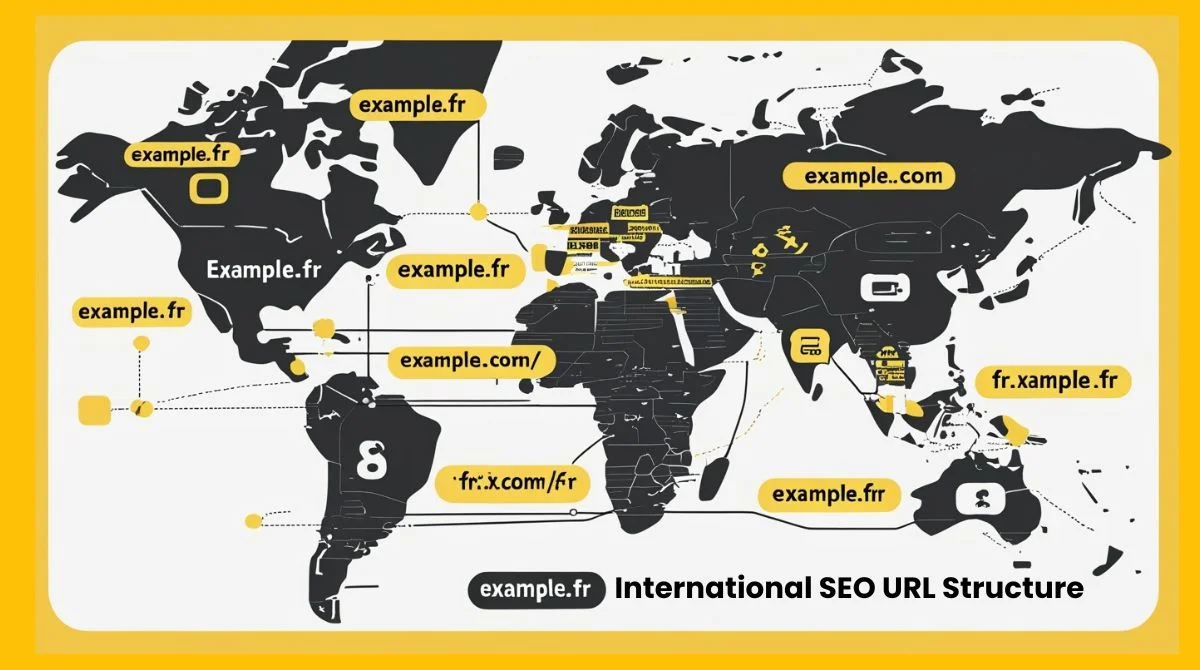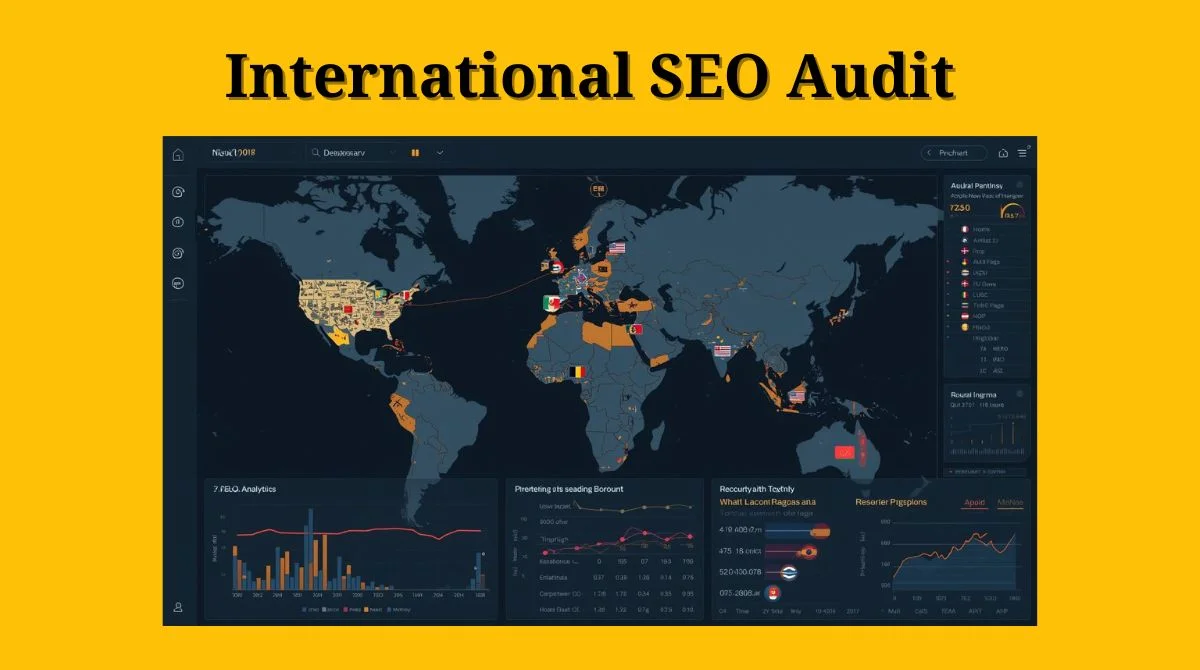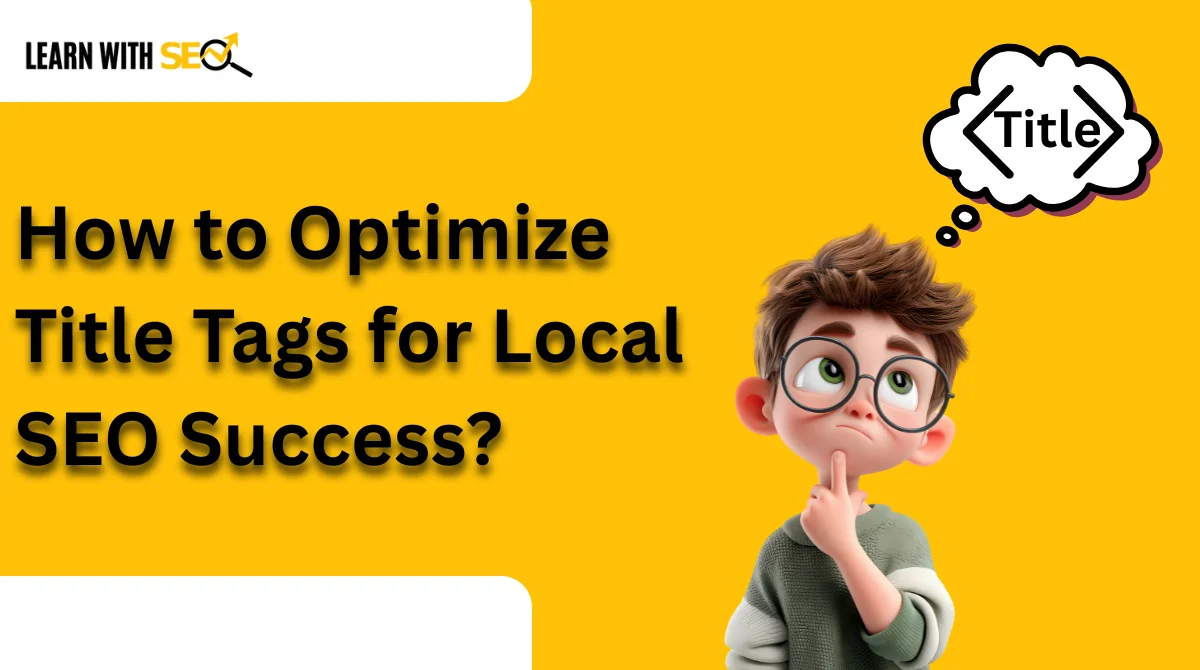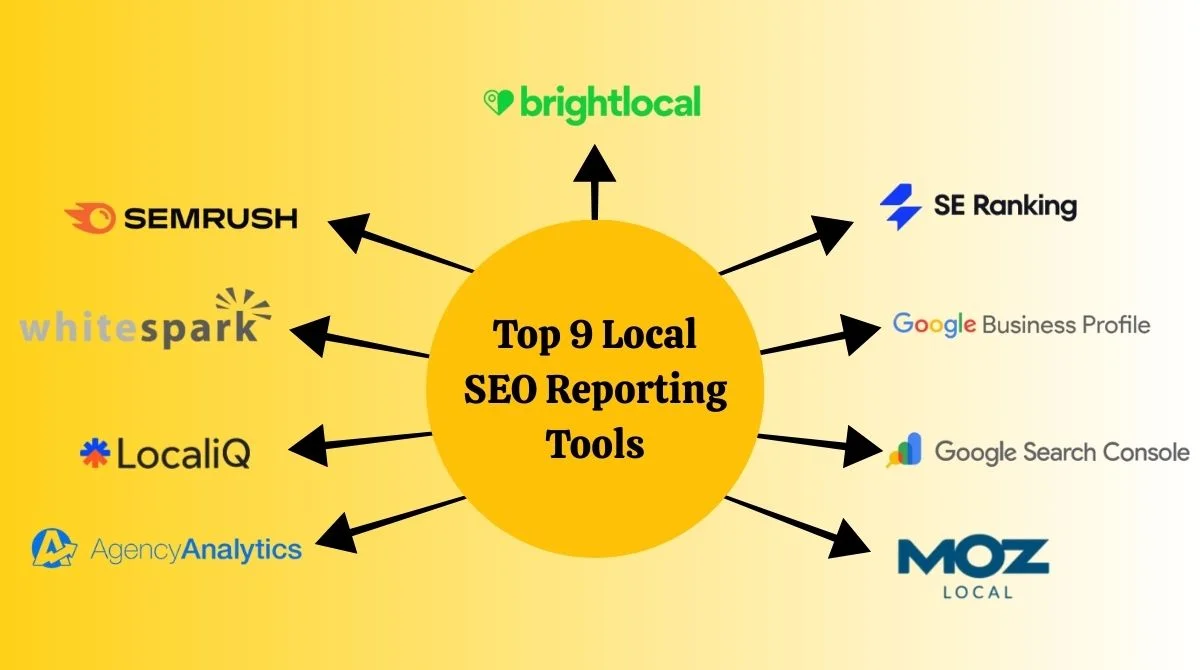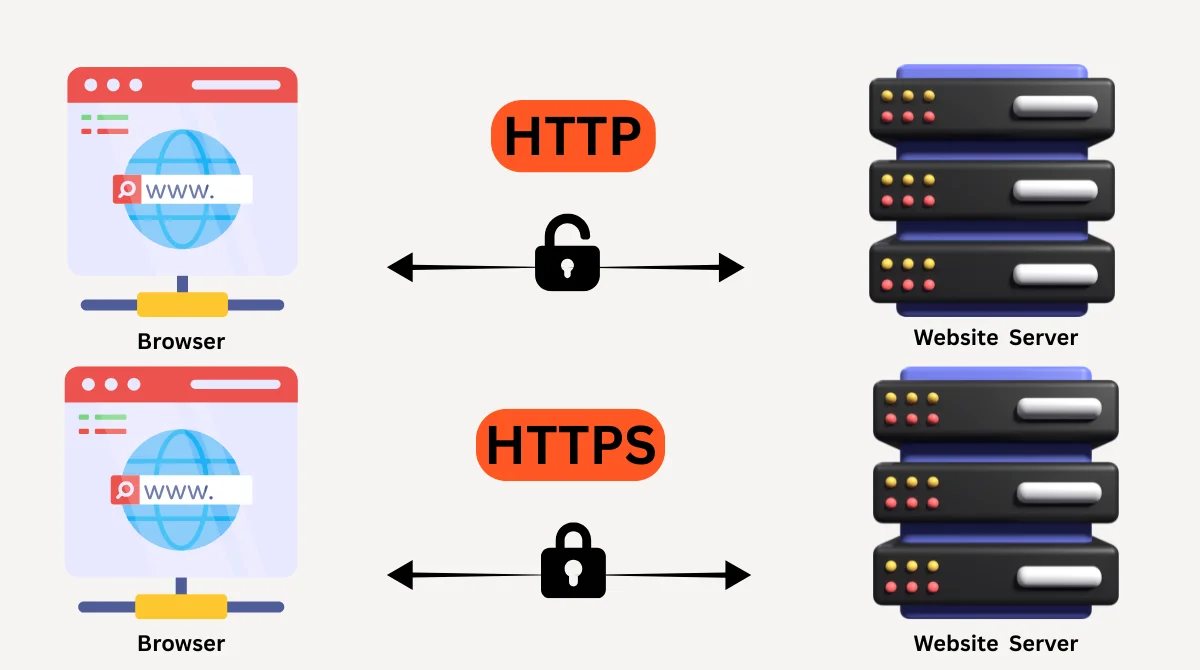- Why Does Google Update Its Algorithm?
- Types of Google Algorithm Updates
- Famous Google Updates Over Time
- Recent Major Updates: June & August 2025
- How Do Google Updates Affect Websites?
- How to Stay Safe During Google Updates?
- Signs That a Google Update Has Affected You
- What To Do If Your Site Gets Hit?
- Why E-E-A-T Matters in Google Updates?
- Final Thoughts
If you’ve ever wondered why some websites show up at the top of Google search results while others stay hidden, the answer lies in Google’s algorithm. An algorithm is like a recipe Google uses to decide which pages deserve to rank higher. From time to time, Google makes changes to this recipe, and those changes are known as Google algorithm updates.
These updates are not random. They are designed to make search results more accurate, helpful, and safe for people who rely on Google every day. If you own a website or work in digital marketing, understanding algorithm updates is one of the most important things you can do to keep your site visible online.
Why Does Google Update Its Algorithm?
Google’s main mission is simple: to organize the world’s information and make it universally accessible and useful. To achieve this, Google must constantly improve how its search engine understands web pages and matches them with what people are searching for.
Here are some common reasons Google updates its algorithm:
- Improving the quality of results: To reward original, helpful, and trustworthy content.
- Fighting spam: To stop low-quality or manipulative websites from ranking.
- Understanding search intent: To better match results with what people really want.
- Adapting to technology: As AI, voice search, and mobile usage continue to grow, the algorithm must evolve accordingly.
- Supporting user trust: By highlighting safe, credible, and authoritative websites.
In short, updates are meant to serve people, not websites. That’s why focusing on creating valuable content for users is always the best long-term strategy.
Types of Google Algorithm Updates
Not all Google updates are the same. Some are small adjustments you’ll barely notice, while others can completely change the search results overnight. Here’s a breakdown:
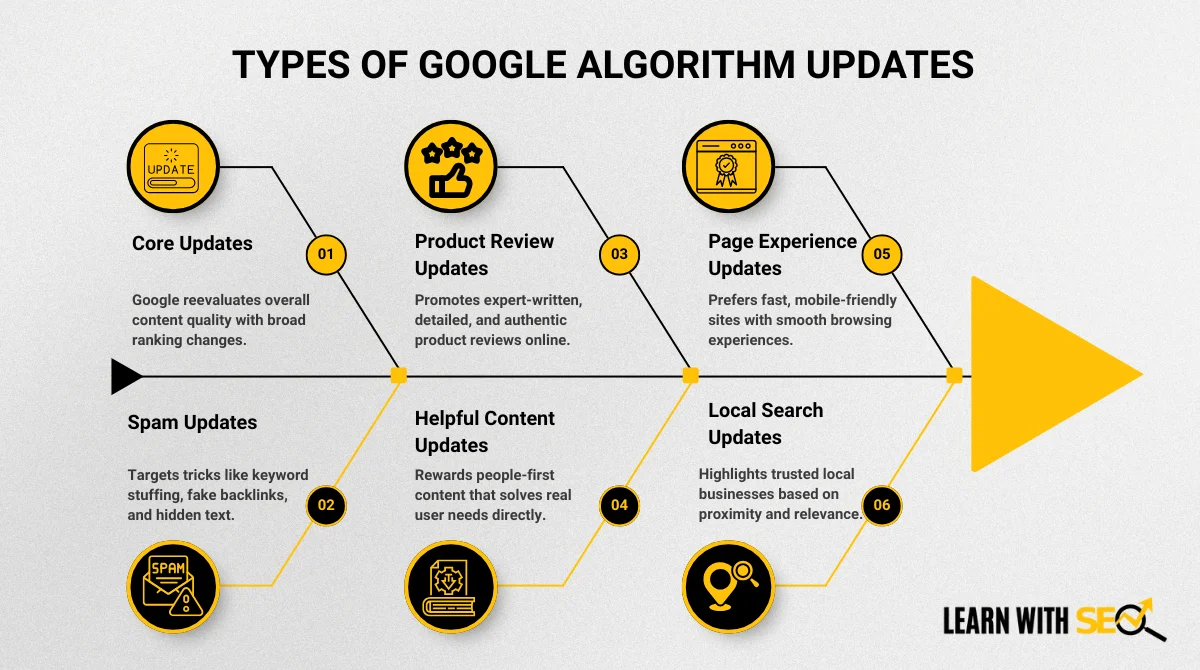
1. Core Updates
These are the most important updates and usually happen a few times each year. Core updates are like a full health check of Google’s system. They don’t target specific sites but instead change how Google judges overall content quality. Websites with strong, helpful, and trustworthy content often see growth, while those with weak or outdated information may lose rankings.
2. Spam Updates
The goal of spam updates is to clean up search results. They target websites that try to cheat the system using tricks like keyword stuffing, hidden text, fake backlinks, or misleading redirects. In simple words, spam updates make sure only genuine and safe sites stay visible, protecting users from harmful or low-value content.
3. Product Review Updates
These updates are focused on review-based content, like blogs comparing products or giving recommendations. Google wants to show reviews that are written by people with real knowledge and experience instead of shallow or copied reviews. Websites that provide detailed insights, pros and cons, and personal experiences with products often benefit.
4. Helpful Content Updates
This update is all about putting people first. It rewards sites that create content for readers rather than just for ranking on Google. If your content is unique, solves problems, and answers real questions, you’ll benefit. On the other hand, sites filled with AI-spun, duplicate, or keyword-stuffed content may lose visibility.
5. Page Experience Updates
Here, Google looks beyond content and focuses on the user’s browsing experience. A page that loads quickly, works smoothly on mobile, and avoids annoying pop-ups will rank better. It’s all about making sure people have a pleasant time when they visit a website.
6. Local Search Updates
These updates affect businesses that show up in local searches, like “plumber near me” or “best pizza in California.” Google fine-tunes local ranking signals such as proximity, relevance, and business reputation. The aim is to give searchers the most accurate and nearby results possible.
Famous Google Updates Over Time
Google has been updating its search algorithm for many years. Here are some of the most famous updates that had a big impact on website owners and SEO professionals:
- Panda (2011): Targeted thin, duplicate, or low-quality content.
- Penguin (2012): Penalized spammy backlinks and unnatural linking practices.
- Hummingbird (2013): Improved understanding of search intent (what people are actually looking for) and natural language.
- RankBrain (2015): Introduced Artificial Intelligence (machine learning) to match user queries with content better.
- BERT (2019): Began understanding the context of search queries more deeply, not just focusing on keywords but also considering sentence structure and grammar.
- Helpful Content (2022): Reduced the visibility of content written only for search engines, while rewarding user-first, valuable, and helpful content.
Recent Major Updates: June & August 2025
Here are two recent updates that were especially important for websites and SEO in 2025:
June 2025 Core Update
- Rollout started: June 30, 2025
- Completed: July 17, 2025 (about 16 days and 18 hours later)
- Purpose: To “better surface relevant, satisfying content for searchers from all types of sites,” in other words, giving value to content that is more helpful to users.
- Effects: Some websites that were negatively impacted by earlier updates, like the Helpful Content Update (HCU) or review system updates, saw recovery, while others experienced ranking drops. Overall, volatility was high.
August 2025 Spam Update
- Announced and started: August 26, 2025
- Scope: Global, across all languages and locations.
- Type: A “normal spam update,” meaning Google updated its spam-detection systems to block new manipulative tactics and tricks.
- Potential effects: Local businesses and Google Business Profiles (GBPs) showed changes. Sites using spammy SEO or content tactics could see ranking drops.
How Do Google Updates Affect Websites?
Whenever Google rolls out an algorithm update, it’s like changing the rules of a game. Some websites win, some lose, and some don’t notice any difference. These changes aren’t random; they reflect Google’s ongoing effort to make search results more useful and trustworthy for people.
Here’s what can happen when an update is released:
- Drop in Rankings: If your content doesn’t meet Google’s quality standard, for example, if it’s outdated, thin, or poorly written, your website may lose visibility. This drop isn’t a penalty but rather a signal that your site is no longer the best match for what users are searching for.
- Increase in Visibility: On the flip side, if your website offers valuable, in-depth, and trustworthy content, you may see a rise in rankings. Google rewards sites that genuinely help users and provide reliable answers.
- Fluctuations During Rollout: Sometimes, you’ll notice your site going up and down in search results while the update is still rolling out. This is normal because Google tests and adjusts results until the update is fully completed.
- Loss of Trust (Penalties): If your site relies on spammy tricks like keyword stuffing, fake backlinks, or copied content, an update could cause a sharp decline in traffic. In severe cases, your site may be flagged, leading to long-term ranking issues.
In short, these updates aren’t punishments. They are signals that Google’s system is now valuing different qualities in content. The goal is always to push helpful, high-quality websites to the top while filtering out low-value or manipulative ones.
How to Stay Safe During Google Updates?
The truth is, no one can predict exactly how a Google update will affect their website. But one thing is clear: websites that focus on long-term quality and user value usually survive and even benefit from updates, while those that rely on shortcuts or tricks often lose out.
Google itself has said many times:
“Don’t chase the algorithm, focus on your audience.”
That means if your site genuinely helps people, you don’t need to worry too much about sudden updates.
Here are some practical ways to stay safe:
- Create High-Quality Content: Write articles and pages that are original, detailed, and useful. Think about what real users want to know and provide complete answers. Avoid shallow or duplicate content because Google’s updates are designed to filter it out.
- Follow E-E-A-T (Experience, Expertise, Authoritativeness, Trustworthiness): Google wants to rank websites that people can trust. You can show this by adding author bios, citing reliable sources, and sharing your own experience or expertise. For example, a health article written by a certified doctor is naturally more trustworthy than one written with no credentials.
- Optimize for User Experience: A fast, mobile-friendly, and easy-to-navigate website creates a positive experience. If your site loads slowly, is hard to use on phones, or has a confusing design, visitors may leave quickly, and Google notices this behavior.
- Avoid Spammy Tactics: Buying backlinks, stuffing keywords, or using manipulative tricks might work for a short time, but Google updates will eventually catch and penalize such tactics. Focus instead on organic, natural growth.
- Keep Updating Content: Information on the web changes quickly. If your old posts are outdated, refresh them with the latest data, examples, or insights. Google rewards content that stays current and useful.
- Build Brand Authority: Become a trusted name in your niche. When your website is mentioned, cited, or linked by other credible sources, Google sees it as a strong sign of authority. Over time, this helps protect your rankings, even during big updates.
If you treat your website like a long-term investment, building quality, trust, and authority, Google updates won’t feel like a threat. Instead, they’ll become opportunities to rise above competitors who cut corners.
Signs That a Google Update Has Affected You
Not sure if your website has been hit by an update? Look for these signs:
- Sudden drop or rise in organic traffic.
- Keyword rankings are changing drastically.
- Pages that used to rank are disappearing from search results.
- Increase in impressions or clicks without new content.
You can track these changes using tools like Google Analytics, Google Search Console, or SEO platforms such as Ahrefs and SEMrush.
What To Do If Your Site Gets Hit?
It can feel stressful when your website suddenly loses traffic after a Google update. But the first rule is simple: don’t panic. Google has said many times that there’s no instant fix for update-related drops. Instead of looking for shortcuts, think of it as an opportunity to improve your website and make it stronger for the long run.
Here are some smart steps to take:
- Audit Your Content: Go through your website and look for weak spots. Thin content (very short or shallow pages), duplicate pages, or outdated posts often get pushed down in rankings. Identify these and either improve them with more valuable information or remove them altogether.
- Analyze Competitors: Check which websites gained visibility during the update. Study what they’re doing right: are they writing deeper content, using better visuals, or offering a clearer structure? Learning from your competitors can give you clues about what Google now prefers.
- Improve E-E-A-T (Experience, Expertise, Authoritativeness, Trustworthiness): Add credibility to your site. Update old articles with fresh data, add author bios that highlight real expertise, cite trustworthy sources, and show users why they should trust your content. The more credible you look, the better Google sees you.
- Fix Technical Issues: Even great content can suffer if your site has technical problems. Make sure your pages load quickly, your design works on all devices (especially mobile), and broken links are fixed. A smooth user experience tells Google your site is reliable.
- Be Patient: Recovery from a Google update doesn’t happen overnight. It may take weeks or even months before you start to see results from your improvements. During this time, keep publishing high-quality, helpful content and focus on consistency.
Why E-E-A-T Matters in Google Updates?
E-E-A-T stands for Experience, Expertise, Authoritativeness, and Trustworthiness. It’s a guiding principle for content quality. Updates often reward sites that demonstrate strong E-E-A-T.
- Experience: Content created by someone with firsthand knowledge.
- Expertise: Content written by an expert in the field.
- Authoritativeness: Backlinks, mentions, and citations from trusted sites.
- Trustworthiness: Clear contact info, secure site (HTTPS), and accurate claims.
If you consistently build content with E-E-A-T in mind, algorithm updates are more likely to benefit you rather than harm you.
Final Thoughts
Google updates aren’t punishments; they aim to improve search for users. The best way to stay safe is simple: focus on helpful, people-first content and solid SEO practices. Treat updates as opportunities to refine your strategy, build trust, and add long-term value. In short: write for people first, optimize for search engines second.


